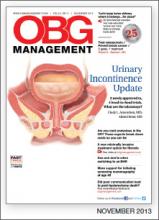November 2013
I object to the tone of the recent commentary by Dr. Errol Norwitz. Although I agree with the concerns he raised, I object to his “tactics.” The subject line of the email I received about this commentary (“Let’s keep home delivery where it belongs…for pizza!”) and some of the comments in the article were inflammatory and almost seem to be making fun of a topic about which many women in our country feel passionately.
As health-care providers, we are skilled at explaining risks and helping people understand how their choices and actions affect those risks. We do this daily without offering insult to patients regarding their beliefs. You don’t need to convince ObGyns that home birth is unsafe—I daresay that most of them already believe that. Awareness of the data and even some of Dr. Norwitz’s insights surely are valuable to the people who are actually pursuing and performing home births—but I feel that the subject line and closing remarks were mean-spirited and serve only to push practitioners and even patients—who need information to make informed decisions—farther away from what Dr. Norwitz argues is the safest care. No one responds well to mockery.
I practice the full scope of nurse-midwifery in a hospital-based practice with excellent physicians to support me and my patients. I do not attend home births, and I, too, have concerns about some home-birth practices and statistics. Honest, respectful communication about the facts is what is needed to improve patient safety and outcomes—not marginalization and disrespect.
Jamie A. Otremba, CNM
Waconia, Minnesota
This article was insulting. When the study by Cheng and colleagues1 was first published, it received enormous criticism, so why has it been revived? Planned home birth with an appropriate provider is safe. The absolute numbers for maternal and newborn problems are very low but sound high when couched in warning language. Let’s not forget the mothers and babies who have problems in the hospital. In fact, the United States has a terrible record when it comes to maternal and neonatal morbidity and mortality—figures based almost entirely on hospital deliveries.
Low-risk women choose home birth to avoid a delivery that often results in far too many non-evidence-based interventions. Why don’t we change the system to make it work? If ObGyns would participate in a collaborative system of care that allows seamless integration of midwives into the acute-care setting when women are no longer low-risk, home-birth statistics would improve tremendously.
ObGyns are surgeons and specialists in problem-solving. Midwives are specialists in low-risk care, and they are adept at continuously assessing their patients to assure that they remain low-risk, consulting or transferring when necessary. Far too many physicians are “turf-conscious,” refusing to collaborate with midwives. It sounds to me as though the risk in home birth is iatrogenic, caused by the very physicians who claim that it is unsafe.
Chris Hilderbrandt, ARNP, CNM
Largo, Florida
I believe that the risk figures—bolded and supersized at the beginning of Dr. Norwitz’s commentary—are somewhat misleading. The intended message is clear but something very important is missing: The scores and risk values for home births were not isolated and compared between skilled midwives attending the births versus unskilled and untrained “other midwives.” In that light, when one considers the difference in risk—0.37% risk for an Apgar score of less than 4 for a home birth (which involves mainly nonprofessional labor attendants) and 0.24% for a hospitalized, medically managed birth, it is remarkable that the difference—0.13%—is so small.
I realize the importance of striving to bring any risk close to zero, but the way the data were presented unfairly implies that home births are essentially more risky than hospital births. It simply may be that they are attended by less-skilled people.
In addition, Dr. Norwitz noted that, in countries where home birth is integrated into the health-care system, there is a twofold to threefold increase in neonatal death. However, a 2011 article by van der Kooy and colleagues2 contradicts that claim, showing no significant difference in neonatal deaths between planned home birth and hospital birth for low-risk women in the Netherlands. I suppose, depending on the vantage point, there is a study somewhere that will support any of our beliefs.
Please make no mistake. I have never been a proponent of home birth. Even a small risk becomes 100% for the individual who suffers any kind of ill effects or damage. But I am a promoter of natural birth and minimal medical intervention. I abandoned obstetrics years ago when I saw firsthand that the increasing focus on technology and medical intervention moved the woman and her experience to the outer margins. The situation has not improved, and the strides made early on by the women’s movement have all but disappeared as women are aggressively convinced that technology and “controlled” interventions will grant them safe passage. In the process, they lose a sense of their autonomy and participation in one of the most important events in their lives.


